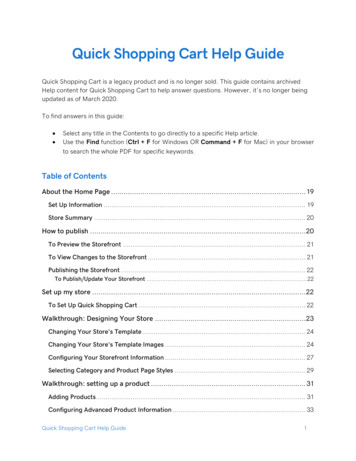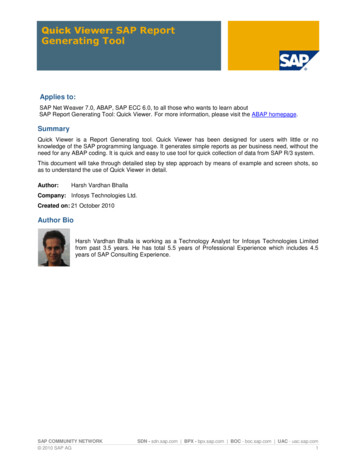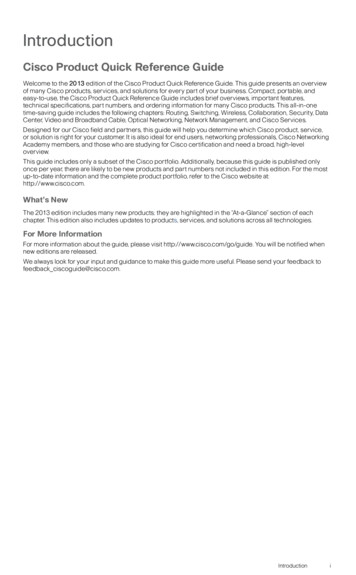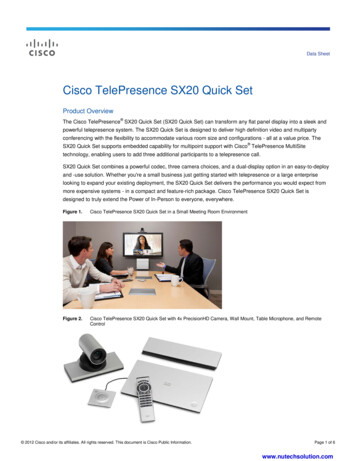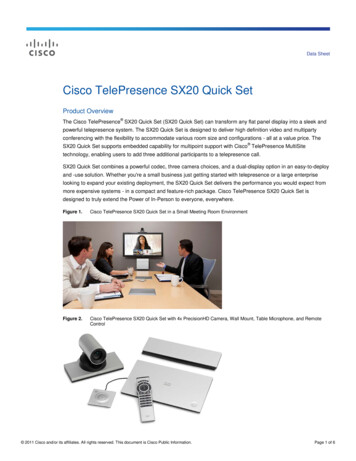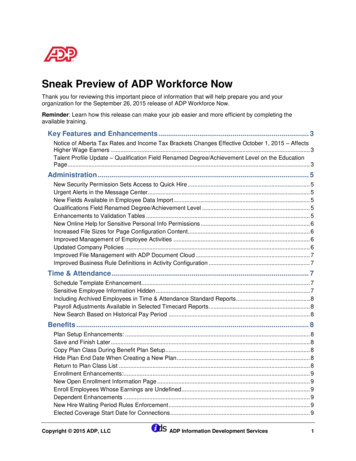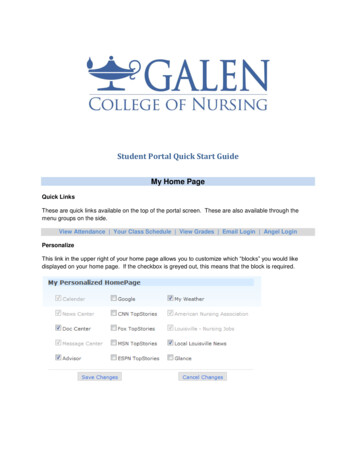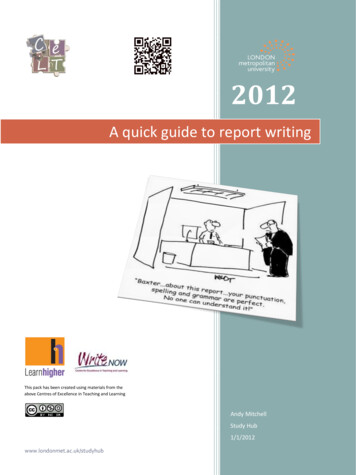
Transcription
2012A quick guide to report writingThis pack has been created using materials from theabove Centres of Excellence in Teaching and LearningAndy MitchellStudy Hub1/1/2012www.londonmet.ac.uk/studyhub
What is a report?The essence of the report is that it is designed to deal with the real world. Specifically, a report is aclearly structured document that presents information clearly and succinctly. Reports should be easyto read and presented professionally. Reports are used to help make decisions or account for actionsand use research to make recommendations.There are many different types of reports including business reports, scientific lab reports and casestudy reports. The common feature of all reports is that they are structured into sections withheadings.Why write reports?Whilst essays are theoretical and discursive, reports are designed to be practical, evaluative andanalytical. Reports give you practice at developing different aspects of your written communicationskills. More importantly perhaps, there are two characteristics to reports that make them significantfor you: Reports on courses model the reports we will write in our jobs. Writing reports at university thereforeprepares us for the work we will do.Reports also model academic journal articles. Writing reports at university can be academicallychallenging and may prepare us for publishing our own research.Why write reports: explain the world or change it?There are three main forms of reports: factual, instructional and persuasive; each has a differentpurpose and will require different arguments and evidence to achieve that purpose. It will help youwrite good reports if you know what you are trying to achieve before you start your report.FactualInstructionalPersuasiveThe factual or informativereport is expected todefine or establish acurrent situation. Theschool report might fallinto this category.The instructional, explanatory, report issupposed to explore a situation andsuggest a range of options for furtheraction. The ‘Which?’ report might fallinto this category.The persuasive or leadingreport is supposed toinvestigate a problem andsuggest a specific course ofaction. A surveyor’s reportmight fall into this category.The line between these reports is blurred, but do try to set your goals before you start your ownreport.www.londonmet.ac.uk/studyhub
Differences between reports and essaysFunctionA Report.An Essay.Presents informationPresents an argument and is ideabasedIs used to make decisions or accountfor actionsIs meant to be scanned quickly by thereaderStructureUsed to demonstrate knowledge,understanding and critical analysisIs meant to be read carefullyFormally structuredSemi-structuredUses numbered headings and subheadingsUses minimal sub-headings and bulletpointsMay not need references andbibliography listAlways requires references and abibliographyUses short, concise paragraphs andbullet pointsRarely uses graphicsUses tables and/or graphs and bulletpointsOffers conclusions about a questionWill only need an abstract if very longMay need an abstract (also known asan executive summary)May need to be followed byrecommendations and/or appendicesHow do I analyse my task?Analysing your task is very important. If you haven't got a clear picture in your mind of where youwant to go, planning the report is going to be difficult. So, here are some questions you should askyourself: Do you understand the type of report needed?Do you know how big your report needs to be?Do you know what is required in the report?Who is my audience? (E.g. lecturers, assessors,managers etc.)What is the problem/question?What is the aim of the report?What key points or issues need addressing?What information do you need to collect?How do I consider the audience?As you write, ask yourself: Why have they asked for a report? What do they need to know? How will they use the report?Now that you've got these basic ideas in mind, how and where will you find the relevantinformation?www.londonmet.ac.uk/studyhub
Types of ReportLiteratureGeneral d BusinessResearch1.Title pageTitle pageTitle pageTitle pageTitle pageTitle pageTitle tionExecutive summaryExecutive erials and methodsMain body of textAcknowledgementsIntroduction4.Main body of ble of contentsMethod/methodology5.ConclusionMaterials and methodsResultsConclusionMain body of onclusionDiscussion7.DiscussionMaterials and ryBibliography10.www.londonmet.ac.uk/studyhub
Sections of a reportResearch reports are the most common type of report. The table below outlines the requirements ofthe different sections. Although this table is concentrating on a research report, many of the sectionsare applicable to other types of reports.Sections of a ReportSectionFeaturesAsk yourselfTitle Table of contentsExecutive Summary (Abstract) Introduction Title of reportName of student/authorCourse/OrganisationDateLists the content of the reportPage numbersSummarises the whole report in a logicalorderOutlines purpose, research methods,findings and recommendationsWritten in past tenseNo more than a pageWritten lastOutlines context, background andpurposeDefines the terms and sets limits of theresearch Method sGlossaryReferences or BibliographyAppendixwww.londonmet.ac.uk/studyhub Explains the research methodology andmethods usedIn scientific reports, you details theexperiment proceduresPresent the findings/resultsYou can use visual data, such as graphs,tables etcFacts only, do not interpretInterprets and evaluates resultsAnalyses resultsBrief summary of findingsRelate your conclusions to the objectivesDo not introduce new informationSuggest suitable changes and/orsolutions Action plan for recommendations ifrequiredList of terms e.g. for acronymsList of cited referencesAttachments e.g. surveys, questionnaires Are the aims of the purpose ofthe report clearly stated?Are the results summarised?Are the limits outlined?Are the important concepts andterms defined?Is the purpose of the researchclearly stated?Is the context and backgroundexplained?Are the limits of the studyoutlined?Are the important concepts andterms defined?Are the researchtechniques/methods clearlyoutlined?Are the results clearsummarised/stated?Are you using tables and graphsetc appropriately?Are the results explained andinterpreted?Are the results linked to othersimilar research and to eachother?Are the results summarised?Do the recommendationssuggest possible solutionsand/or actions etc?
Report StructureGeneric exampleYour table of contents may vary depending on the type and function of your report.PageNumbersTitle pageExecutive summary1Table of contents21. Introduction1.1. Purpose of the report1.2. Issues to be discussed and their significance1.3. Research methods1.4. Limitations and assumptions2. Discussion2.1 Literature review2.1.1 Issue 12.1.2 Issue 22.1.3 Issue 32.2 Method2.2.1 Procedures2.2.2 Sample size2.2.3 Selection criteria2.3 Discussion and analysis of data2.3.1 Issue 12.3.2 Issue 22.3.3 Issue 32.3.4 Reliability and accuracy of data3. Conclusions4. Recommendations4.1 Recommendation 14.2 Recommendation 25. References/Bibliography6. Appendices7. Glossarywww.londonmet.ac.uk/studyhub3etc.etc.
Report checklist123 What is the purpose of this report and has it fulfilled that clearly? Does the report cover all the key points? Do you offer sufficient evidence to ‘prove’ yourpoints? Did you analyse your evidence/data in enough depth?4 Does your conclusion follow logically from your arguments, and do yourrecommendations follow logically from your conclusions?5 Is the language, tone, style and pitch clear, direct and formal, suitable for the reader andthe subject?6 Is the grammar, punctuation and spelling correct? Is the report the correct length?7 Is the layout simple, clear, logical and consistent, with conventional sections, headings,labels and numbers? Is the right material in the right sections?8 If illustrations such as figures and tables have been included, are they clear andpurposeful, usefully integrated and properly referenced?9 Have you used an appropriate number and range of sources? Have all sources andreferences been acknowledged, in the main body and at the end in a list of references?101112 Should there be a glossary? If there is one, is it comprehensive? Are the appendices clearly labelled? Is the reader directed to each appendix in the bodyof the report? Have you left the report on one side for a while before going back to review and edit it?www.londonmet.ac.uk/studyhub
The highlighted sections make up the Main Body of the report.Organise these sections in a logical sequence: what you investigated,what you found, what interpretations and what judgements you made.Use short informative headings and subheadings.www.londonmet.ac.uk/studyhub
Web ://www2.napier.ac.uk/getready/writing /course/view.php?id 3359http://www.lc.unsw.edu.au/onlib/labrep.html
MindmapAdapted from: http://learnhigher.ac.uk/resources for re-of-a-report.htmlwww.londonmet.ac.uk/studyhub
A quick guide to report writing . There are many different types of reports including business reports, scientific lab reports and case study reports. The common feature of all reports is that they are structured into sections with . Is the language, tone, style and pitc
